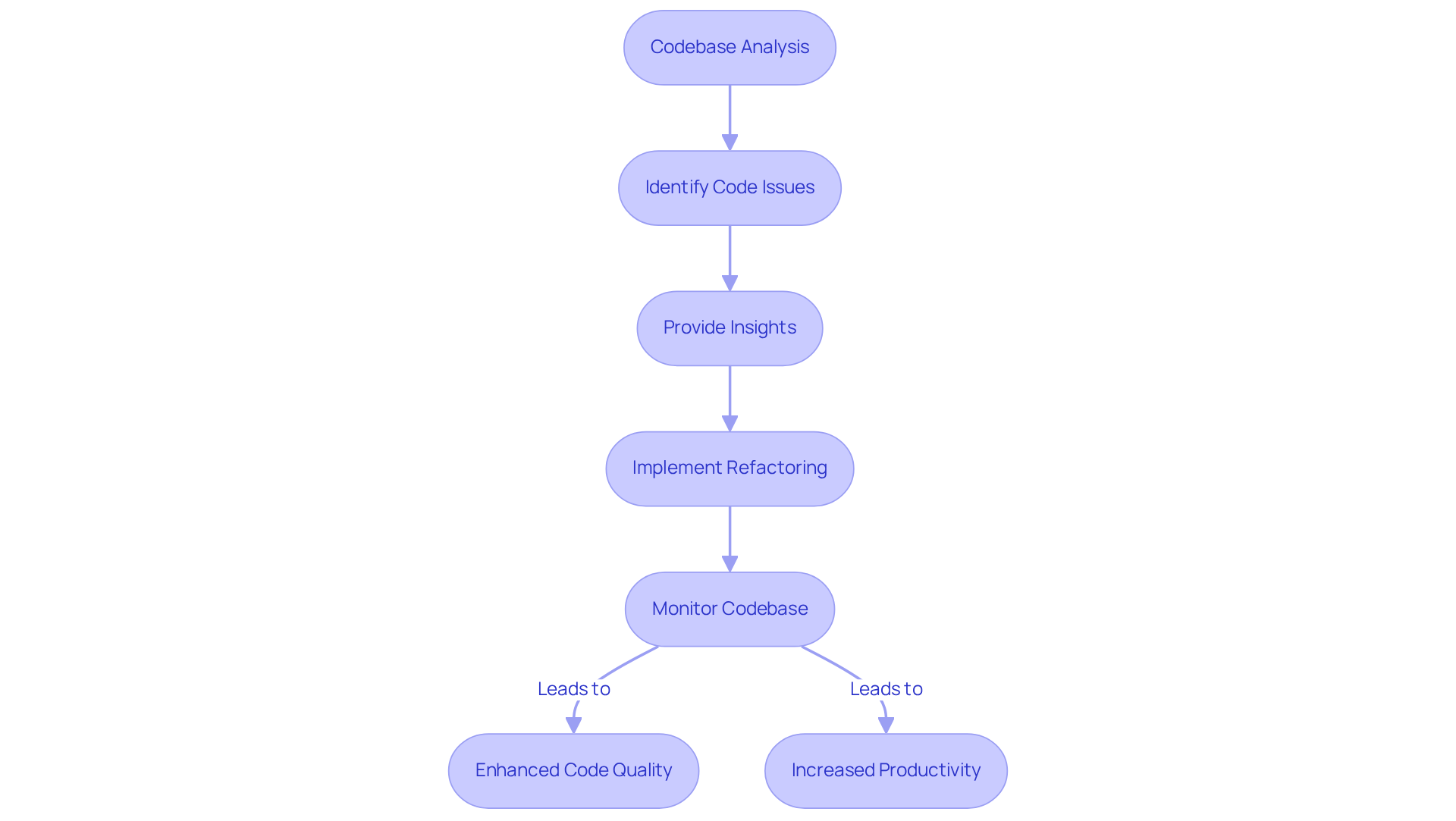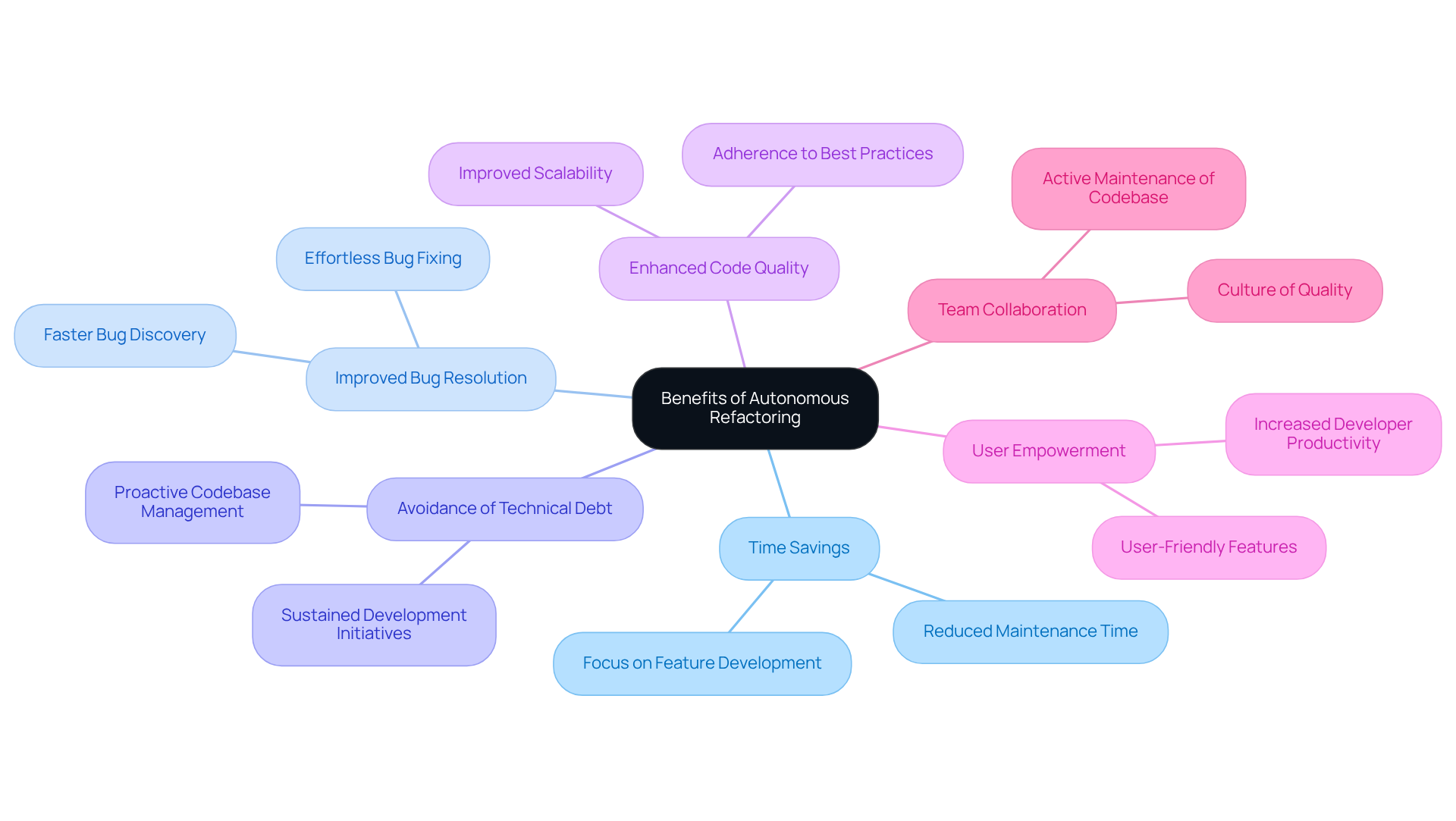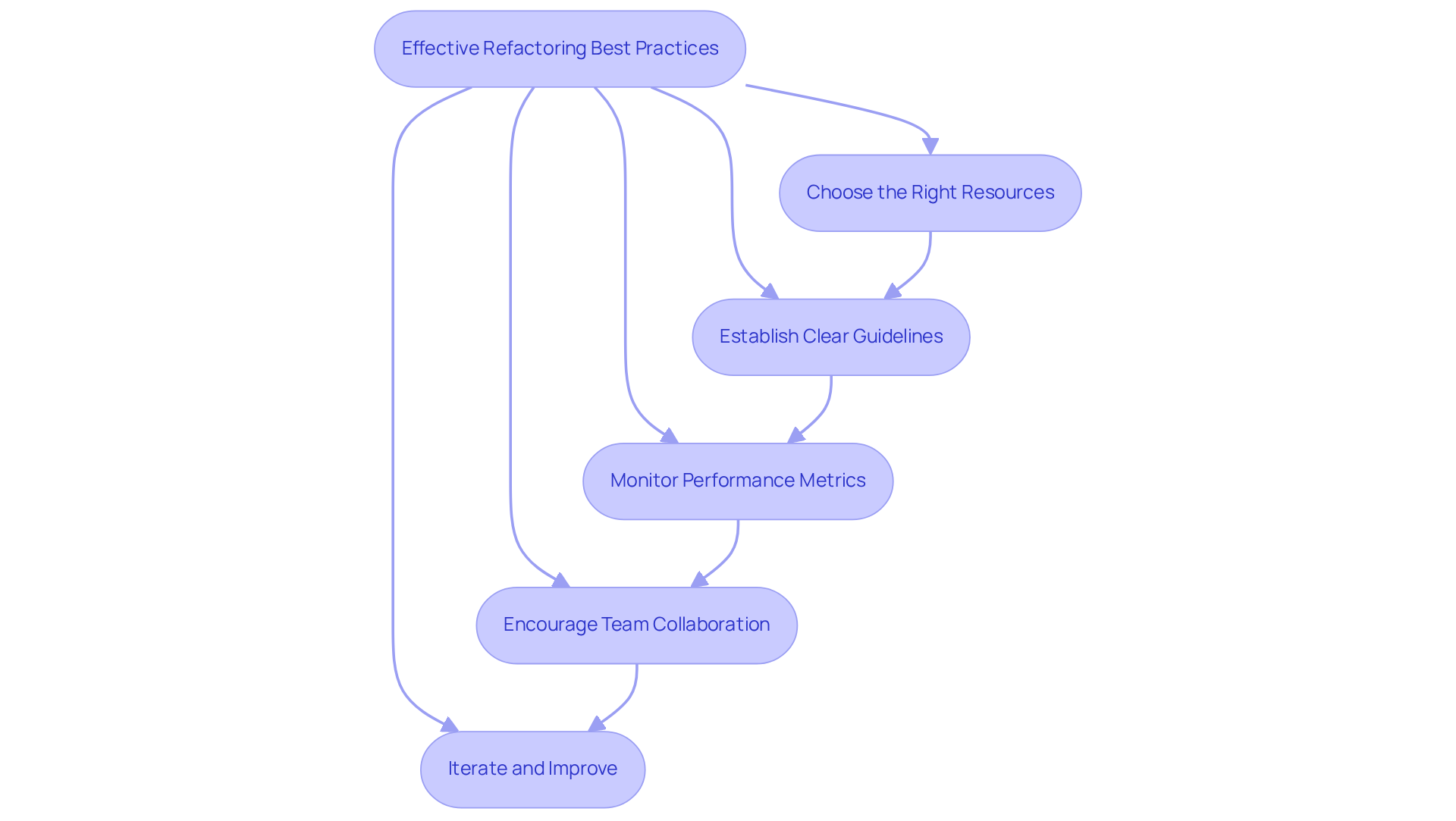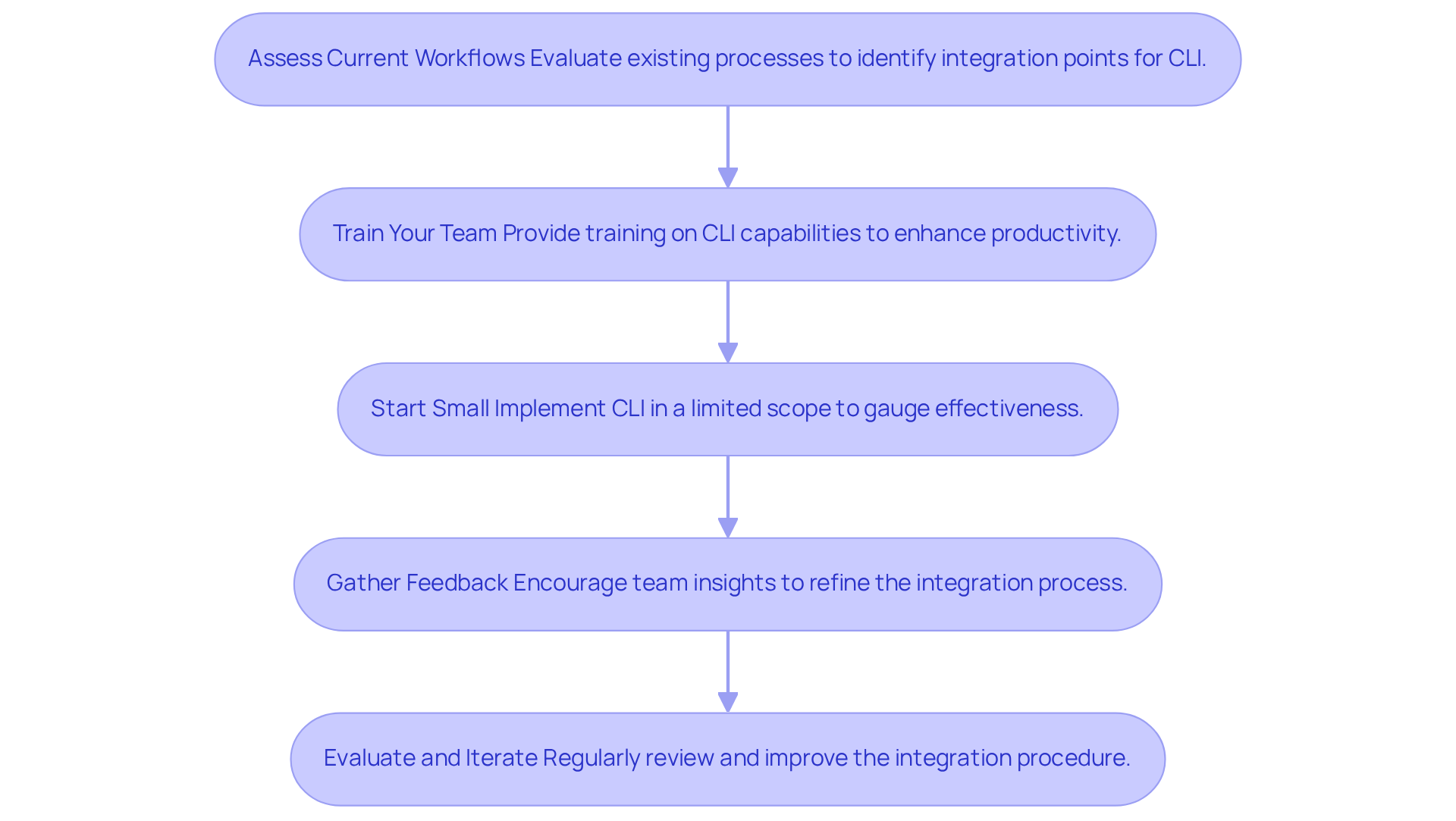Overview
Developers often face significant challenges in maintaining code quality and efficiency. How can these obstacles be effectively addressed? Enter Kodezi, an AI-driven tool designed to enhance coding practices. By leveraging its capabilities, teams can streamline their workflows and significantly improve their coding efficiency.
Selecting the right resources is crucial for effective code refactoring. Kodezi not only provides the necessary tools but also establishes clear guidelines that help developers navigate complex coding tasks. Furthermore, monitoring performance metrics allows teams to assess their progress and make informed adjustments along the way.
In addition to these features, Kodezi fosters collaboration within teams, encouraging open communication and shared problem-solving. This collaborative approach leads to improved code maintenance and significantly reduces technical debt, creating a more productive development environment.
Are you ready to elevate your coding practices? Explore the tools available on the Kodezi platform and discover how they can transform your development experience, enhancing both productivity and code quality.
Introduction
In the realm of software development, the quest for efficiency often leads to the challenge of managing code quality amidst the complexities of evolving projects. Developers frequently face difficulties in maintaining high standards while navigating these challenges. Autonomous code refactoring emerges as a powerful ally in this context. Tools like Kodezi harness AI to streamline the identification and resolution of coding inefficiencies, alleviating the exhaustive manual effort typically required.
As developers seek to enhance their productivity, they must consider how Kodezi addresses these challenges. By automating the refactoring process, Kodezi not only saves time but also ensures that code quality remains high. This tool allows developers to focus on more critical tasks, ultimately leading to a more efficient workflow.
The benefits of using Kodezi are clear: improved productivity and enhanced code quality. As developers adopt best practices in autonomous refactoring, they can transform their individual coding tasks and the overall development workflow. How can embracing these tools lead to a more streamlined approach in your projects? Explore the features and benefits available on the Kodezi platform to discover how it can revolutionize your coding experience.
Understand Autonomous Code Refactoring
In the fast-evolving world of software development, developers often encounter significant coding challenges, such as code inefficiencies and vulnerabilities. The process of autonomous code refactoring, particularly through tools like Kodezi, offers a solution by leveraging AI-driven technology to automatically analyze and improve code without the need for human intervention. Unlike traditional refactoring methods that require extensive manual effort, Kodezi employs advanced machine learning algorithms to swiftly identify and rectify issues within the codebase, including code smells and performance bottlenecks.
Furthermore, this innovative approach not only elevates code quality but also dramatically reduces the time and effort associated with maintenance tasks. By providing detailed explanations and insights into the identified problems, Kodezi ensures that users understand the underlying issues and the methods used for resolution. This transparency fosters a deeper comprehension of coding practices, empowering developers to enhance their skills.
In addition, Kodezi continuously monitors the codebase, using autonomous code refactoring to suggest or implement changes that improve performance, readability, and compliance with the latest security best practices and coding standards. The benefits of utilizing Kodezi are clear: increased productivity, enhanced code quality, and a more efficient development process.
Are you ready to transform your coding practices? Explore the powerful tools available on the Kodezi platform and experience the shift towards automation that is essential for maintaining a clean and efficient codebase in today’s fast-paced development environments.

Recognize the Benefits of Autonomous Refactoring
Coding challenges can be overwhelming for developers, especially when it comes to routine maintenance tasks. Fortunately, Kodezi offers an innovative solution to these common issues. With utilities like CLI, it significantly reduces the time spent on maintenance, allowing developers to focus on feature development and innovation. Users have reported that Kodezi helps them discover and resolve bugs more quickly and effortlessly than traditional methods, serving as a lifesaver for addressing issues.
Furthermore, by consistently overseeing and enhancing the codebase, Kodezi helps avert the buildup of technical debt, which can obstruct future development initiatives. Autonomous code refactoring enhances code quality by ensuring adherence to best practices and coding standards, ultimately leading to more maintainable and scalable applications. Testimonials highlight how Kodezi's user-friendly features, including code commenting and debugging tools, empower developers and enhance productivity.
In addition, incorporating self-sufficient resources into the development workflow can enhance team collaboration. Developers can rely on the codebase being actively maintained and improved without constant supervision. This proactive approach not only boosts productivity but also fosters a culture of quality within engineering teams.
Are you ready to transform your coding practices? Explore the tools available on Kodezi to experience these benefits firsthand.

Implement Best Practices for Effective Refactoring
To implement autonomous code refactoring effectively, teams should consider the following best practices:
-
Choose the Right Resources: Select independent restructuring utilities that integrate seamlessly with your current development environment and workflows. Look for features such as real-time monitoring, automated pull request generation, and compatibility with your version control system to enhance programming productivity.
-
Establish Clear Guidelines: Define coding standards and restructuring guidelines that the autonomous code refactoring systems, including the CLI, should adhere to. This ensures consistency across the codebase and helps maintain quality, allowing teams to auto-heal their codebases effectively.
-
Monitor Performance Metrics: Regularly analyze performance metrics to evaluate the impact of restructuring efforts. This information can assist in recognizing areas for further enhancement and confirm the efficacy of autonomous code refactoring solutions like the CLI in improving code quality and resolving bugs prior to production.
-
Encourage Team Collaboration: Foster an environment where team members can provide feedback on the restructuring process. This collaboration can lead to improved resource selection, such as the CLI software, and more efficient implementation strategies.
-
Iterate and Improve: Treat the implementation of autonomous code refactoring as an ongoing process. Consistently assess the resources and methods in use, including the CLI, making modifications as needed to enhance performance and efficiency.

Integrate Autonomous Tools into Development Workflows
Incorporating autonomous refactoring tools like CLI into development workflows presents a unique set of challenges that developers often face. To effectively tackle these challenges, careful planning and execution are essential. Here’s how to facilitate the integration of CLI into your processes:
-
Assess Current Workflows: Start by evaluating your existing development processes. Identify areas where the CLI can implement autonomous code refactoring to enhance code quality and rectify issues before they reach production. This assessment is crucial for determining the optimal points of integration.
-
Train Your Team: It’s vital to provide training sessions for your team members, familiarizing them with the command line interface and its capabilities. Understanding how to leverage this versatile tool effectively is key to maximizing its benefits in enhancing programming productivity.
-
Start Small: Implement the CLI in a limited scope initially, perhaps within a specific project or code module. This approach allows your team to gauge its effectiveness in autonomous code refactoring and to make necessary adjustments before a broader rollout.
-
Gather Feedback: Encourage team members to share their experiences and insights regarding the CLI. This feedback can guide further enhancements and assist in refining the integration process, ensuring that the tool meets the team’s needs effectively.
-
Evaluate and Iterate: Regularly review the integration procedure and the CLI’s performance. Use these evaluations to make iterative improvements, ensuring that the tool continues to boost programming productivity and adapt to the evolving needs of the development team.
For a quick start, consider utilizing the 5-minute quickstart guide and scheduling a demo to see Kodezi CLI in action. This proactive approach not only enhances your coding practices but also fosters a culture of continuous improvement within your team.

Conclusion
In today's fast-paced software development landscape, developers face significant challenges with code inefficiencies and vulnerabilities. Embracing autonomous code refactoring is essential, as it transforms how these issues are tackled. Tools like Kodezi leverage AI to automate the analysis and enhancement of codebases, resulting in notable improvements in both quality and productivity. This transition reduces the manual effort typically required for refactoring, allowing developers to concentrate on innovation and feature development.
Key practices for effective autonomous code refactoring have been highlighted throughout this discussion:
- Choosing the right tools
- Establishing clear guidelines
- Monitoring performance metrics
- Encouraging team collaboration
- Committing to an iterative improvement process
By implementing these practices, teams can maintain coding standards, manage technical debt, and maximize overall development efficiency.
Ultimately, integrating autonomous tools into development workflows is not merely a trend; it is a necessity for fostering a culture of quality and continuous improvement. Developers are encouraged to explore the capabilities of tools like Kodezi, as they can significantly enhance coding practices and streamline maintenance tasks. Embracing these innovations will not only improve code quality but also position teams to thrive in an increasingly competitive landscape.
Frequently Asked Questions
What is autonomous code refactoring?
Autonomous code refactoring is the process of automatically analyzing and improving code using AI-driven technology, without the need for human intervention.
How does Kodezi contribute to autonomous code refactoring?
Kodezi uses advanced machine learning algorithms to quickly identify and rectify issues in the codebase, such as code inefficiencies, vulnerabilities, code smells, and performance bottlenecks.
What are the advantages of using Kodezi for code refactoring?
The advantages of using Kodezi include increased productivity, enhanced code quality, reduced time and effort in maintenance tasks, and a more efficient development process.
How does Kodezi help developers understand code issues?
Kodezi provides detailed explanations and insights into identified problems, helping users understand the underlying issues and the methods used for resolution, which fosters a deeper comprehension of coding practices.
Does Kodezi offer ongoing support for code quality?
Yes, Kodezi continuously monitors the codebase and suggests or implements changes to improve performance, readability, and compliance with the latest security best practices and coding standards.
What impact does autonomous code refactoring have on software development?
Autonomous code refactoring significantly elevates code quality and reduces the time and effort associated with maintenance tasks, leading to a more efficient development process.




